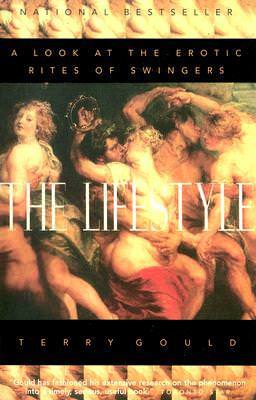
Kasidie: I’ve really been looking forward to speaking with you. Your book has had a huge impact on me. When I started reading The Lifestyle: A Look at the Erotic Rites of Swingers, I couldn’t put it down. In many ways it has greatly affected the way I view the lifestyle, and it has actually been a driving force behind much of our ideology.
Terry Gould: Thank you, I’m honored.
Kasidie: Your book is unique in contrast to other books about the swinging lifestyle in that you are not actually a swinger yourself. You wrote it purely as an outside observer of lifestyle. Most people who go that deep into the lifestyle or spend that much time around swingers are usually people who are interested in getting into the lifestyle themselves.
Terry Gould: Yeah, let me start by saying it was just a professional engagement of journalism. That’s what I do when I tell a story, I stay with it. I’ve written several books and studied the subject matter for years. That’s not unusual for any journalist. In my case, sometimes organized crime sometimes social phenomena. It takes a long time to treat a subject seriously and understand it and explain it. Not just on the most obvious and spectacular manifestations you see on the outside that can be covered by a daily newspaper but culturally historically morally ethically biologically.
Kasidie: I understand that this book and its research resulted from an earlier article you wrote for a magazine?
Terry Gould: In this case the book was published in 1999 and if we go back ten years before then, I was senior editor of a magazine and I was covering a story on swingers. So I did what a lot of journalists did in those days. I found an ad in a local newspaper, went to a club party and from that wrote an article. The people I encountered that particular night in that particular club were not very flattering to that subculture.
Kasidie: You mean physically?
Terry Gould: In all respects. They didn’t have a heavy degree of self-consciousness. So I wrote an article about that. The important thing to recognize is that when people come in from the outside, as I did, they tend to notice the things they don’t like about the lifestyle first. Because when the subject of sex comes up it becomes personal and you’re more prone to be judgmental. But about a year or two later, I met a woman who was familiar with the lifestyle and she explained that what I had done was given a skewed survey based on this one club of something that was actually a very wide-spread phenomenon and had a lot of other aspects to it. For instance, if I were to do a story of the gay lifestyle and I went to a bondage S&M club and I walked in there and saw people walking around in dog collars. If I walked away and said “This is what it means to be gay”, I’d be giving the readers a skewed survey of a multi-faceted complex subculture, but I would be drawing out the one manifestation of it that actually belied what was going on in all other areas.
Kasidie: That sounds like the standard for most current television journalism.
Terry Gould: Well, especially with sex. Sex is such an easy target. So, anyway this woman invited me to see the other side of things. She belonged to what she called a “Cadillac Club.” It was a ranch out in the country. I was actually very startled. I went to a dance and I saw upper middle class professionals. They were basically from all walks of life, but there was a preponderance of upper middle class people there. They were articulate.
Kasidie: It wasn’t what you expected? Were you shocked?
Terry Gould: I was shocked because there was really nothing to be shocked about. They were sunny suburbanites they basically had an optimistic view of life. They danced, they self-parodied, they had an awareness that the outfits they were wearing could only be worn at a place like this. Some of them had been in it for years. Some went to clubs every Saturday night, others went only once or twice a year. They all knew each other. I got intrigued. I started researching around 1992 or 93 and discovered this was a verifiable subculture which was virtually uniform across the continent. It had rules, etiquette, a main demographic, a travel industry, clubs and rituals. It was like the jazz scene. There was accepted lingo and forms of behavior and they had a name for it, “The lifestyle.”
Kasidie: This is pre-internet?
Terry Gould: I don’t think anybody was on the internet back then.
Kasidie: So this subculture was the same uniformly across the country even before the swinger dating websites popped up?
Terry Gould: Because it had attracted a culture of people who were in it for pretty much the same reason. They called it “the lifestyle” because they lived in a certain kind of style that allowed them to combine their North American middle class values, emotional monogamy, raising children with their North American fantasies of dressing like movie stars and going to exciting parties. They had no where else to express that longing to go to a Mardi Gras party with their spouse. They were primarily in that subculture not to sleep with other people, but to eroticize their own marriages. So you had this cohort of middle and upper middle class people. But they couldn’t show up in a Frederick’s of Hollywood outfit to regular bars or they’d get in trouble. But in the safe bounds of this subculture they could express their sexuality in a very safe environment. I got very intrigued, most journalists in the 80’s took the easy shots at the lifestyle.
Kasidie: I often feel that a lot of this fear of swingers comes from a belief that swingers are going to somehow corrupt the rest of society. As if we’re trying to force our lifestyle on others… which has not been my experience.
Terry Gould: The swinger subculture is basically set up as a conservative institution. The misconception of the lifestyle by the straight world is that it’s just a vehicle for men to have sex with other women while their wives come along. But that’s not what it’s about at all. If it were about that, it would not have grown by such leaps & bounds over the last 20 years, penetrating all ends of the continent and Europe and Australia and doubling and tripling in numbers. Most people use it to spice up their own marriages. Most people will tell you that it wouldn’t be as exciting to just to go to these clubs alone to have mechanical sex with a stranger. They wouldn’t consider it a lifestyle if that was the case.
Kasidie: Your book talks a lot about women and their sexual “power”. I think you used the term “the insatiable female”. You said that a lot of our society’s sexual stigmas stem from fearing the full sexual potential of women.


5 Comments
Terry Gould's book is one of the finer acts of journalism that I've ever read.
It is very serendipitous that you posted this interview as I
just finished reading this book a few weeks ago. It was very informative and I
enjoyed it thoroughly. Although I am not yet into The Lifestyle my wife
recently confessed that she is extremely voyeuristic. We are planning to attend
a local club initially just to observe and we will see where it leads. Keep up
the interesting and informative writing.
B.
“The Lifestyle” is a great book. We have read it, and, every couple should read it regardless of whether or not they have any interest in the swinging Lifestyle. The book really sheds light upon why those of us in the Lifestyle enjoy it so much. Socializing combined with consensual sex with someone else’s wife/girlfriend/husband/boyfriend, one-on-one, or in a group setting is, in our opinion, a most rewarding experience a couple can have. This nonmonogamous lifestyle or subculture is not only ethical but thoroughly enjoyable to boot.
Mr and Mrs.
Fantastic interview, a good read.
Pingback: Can Swinging Improve Your Marriage?